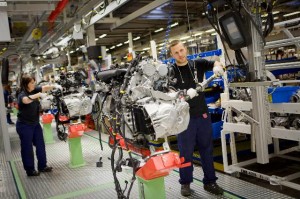In May 2015, automaker Volvo finalized a deal that will move most of its North American production to South Carolina, where its new plant should be operational in 2018, employing 2,000 people and rolling out some 100,000 new vehicles each year.
In coming to the U.S., Volvo is following the lead of Volkswagen, Mercedes, BMW, Toyota and other foreign automakers that have built 30 plants here. Many have settled in South Carolina, which is now home to 250 automakers, tire companies and auto suppliers who employ a total of 58,000 American workers. These firms evidence a broader trend that may be the single brightest beacon of hope for America’s economic future: that of foreign manufacturers coming to U.S. shores to make everything from power plant generators, to power tools, to hardware, to chemicals.
In this, Germany is leading the charge. Indeed, today more than 3,500 German companies—small, medium and large—are now operating here and employing more than 600,000 Americans. And, in an interesting and happy reversal of recent patterns of off-shoring, China is likely to follow. China has earmarked $1 trillion for overseas investing, and a big share of that will find its way to U.S. shores. If that happens, the era of American jobs lost to China will not only end but shift into reverse.
At the same time, many prominent U.S. firms—Apple, General Electric and Brooks Brothers among them—have been “re-shoring” production from Asia. This nascent trend is predicted to grow because of fast rising wages in China (15-20% annually), quality and transport cost issues, and America’s dramatic advantage in energy costs.
These developments point to a renaissance for U.S. manufacturing, and most of the ingredients for that are in place today—superior technology, high customer demand, supply chains, low cost energy, infrastructure and capital. Yet only one thing is in short supply: skilled workers. There simply aren’t enough welders, electricians, robotic technicians, hydraulic specialists, carpenters, machinists and so forth on the street or in the educational pipeline. In fact, economists agree that the U.S. manufacturing industry is currently suffering a “skills gap” of around 500,000. That’s 500,000 jobs just waiting to be filled, if only companies could find adequately skilled candidates. And the gap will only widen as baby boomers drift off to retirement and our economy expands; indeed, the Manufacturing Institute expects the skills gap in manufacturing to reach 2 million by 2025 unless something changes, and fast.

Skilled workers assemble engines at Volvo in Sweden. First North American plant to open in South Carolina in 2018. Photographer: Casper Hedberg/Bloomberg
Fortunately, change is in the wind. After years of marginalizing and under-funding vocational-technical education, some states and communities are finally doing an about-face. The federal government says all the right things about supporting technical education and creating more apprenticeship opportunities to help make high school grads more job-ready and technically effective. But it’s individual states and communities where we are seeing words turned into action. South Carolina, Kansas, North Dakota, Ohio and Wisconsin have been among the best in matching the needs of employers with educational programs offered by their high schools, and community and technical colleges.
Consider the case of an economic development director I met in Pickens County, South Carolina when researching my recent book, Job U. He and his competitors had, for years, been using the same basket of goodies to lure manufacturers to their area, generally without success. “Every one of us was offering tax breaks, infrastructure deals, a low cost of living,” he told me. “But what these companies wanted most was something that none of us could deliver: a deep pool of skilled workers.”
And so his agency partnered with the school district, a local two-year technical college, and leaders from local companies, and developed a plan to deliver what industry needed most. They built a new career-technical high school around a revamped curriculum and state-of-the-art equipment. They worked with the state to create skill-building apprenticeship programs. And they worked tirelessly to help shatter the stigma against vocational work, and open the eyes of students and parents to the limitless— and lucrative—career opportunities in manufacturing. And it worked. Today, the best brand-name manufacturing companies send recruiters to Pickens County to look over the latest crop of tech-savvy students—like Major League football teams sending their scouts to check out the upcoming talent. And it’s a pattern that has repeated itself throughout the Carolinas, and other communities looking to secure a bright economic future.
Fortunately, success stories like this one are becoming more common, not just in the Carolinas but throughout the nation at large. At last, states and communities across America are discovering what northern Europeans have known for more than a century: that collaboration between schools, government and employers is the secret to developing a highly skilled, world-beating work force—the kind of work force we’ll need in order to realize America’s manufacturing renaissance.
The one impediment to this achievement is many parents who would rather walk barefoot on hot coals than have their offspring pursue a career that involves making or fixing things. “Oh, the horror! Those are low-paid, dead-end jobs in dark and dangerous factories or dirty works-shops, right?” Answer: not in the slightest.
With the age of globalization and technological change upon us, investing in 21st century skills building programs is the key ingredient to a strong, prosperous economy.

Published on Forbes here:
http://www.forbes.com/sites/nicholaswyman/2015/07/14/what-is-the-one-thing-that-can-strengthen-americas-economic-armor/
